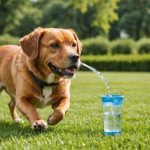Managing Food Guarding Behavior in Your Overprotective Rottweiler: Proven Techniques and Practical Advice
If you’re a dog owner, particularly of a breed as loyal and protective as the Rottweiler, you might have encountered the challenging issue of food guarding. This behavior, where your dog becomes aggressive or defensive when approached while eating, can be intimidating and dangerous. Here’s a comprehensive guide to help you understand and manage food guarding behavior in your Rottweiler.
Understanding Food Guarding Behavior
Food guarding, also known as resource guarding, is a common behavioral issue in dogs. It stems from the instinct to protect valuable resources, such as food, from potential threats. In the wild, this behavior is crucial for survival, but in a domestic setting, it can be problematic.
Also read : Unlocking the secrets of scent training: your ultimate guide to competing with your papillon
Why Do Dogs Exhibit Food Guarding Behavior?
- Instinct: Dogs have an innate instinct to protect their food, a behavior inherited from their wild ancestors.
- Learning: Dogs may learn this behavior through experiences where they feel the need to defend their food from other pets or people.
- Breed Characteristics: Certain breeds, like Rottweilers, known for their protective nature, may be more prone to food guarding due to their genetic predisposition[5].
Signs of Food Guarding
Recognizing the signs of food guarding is crucial for early intervention. Here are some common indicators:
- Growling or Snarling: When your dog growls or snarls when you approach their food bowl.
- Stiffening: If your dog’s body becomes stiff or rigid when you are near their food.
- Showing Teeth: When your dog shows their teeth as a warning sign.
- Resource Holding: If your dog holds onto the food bowl or the area around it.
Assessing the Risk and Taking Precautions
Before diving into the techniques for managing food guarding, it’s essential to assess the risk and take necessary precautions to ensure safety.
Also to see : Early indicators of hip dysplasia in young labrador retrievers: what every owner should know
Evaluating the Severity
- Mild Guarding: If your dog exhibits mild signs like stiffening or slight growling, you can start with gentle training techniques.
- Severe Guarding: If your dog shows aggressive behavior like biting or intense growling, it’s advisable to seek professional help from a dog trainer or behaviorist.
Safety Precautions
- Maintain Distance: Keep a safe distance from your dog while they are eating to avoid triggering the guarding behavior.
- Avoid Sudden Movements: Sudden movements can escalate the situation, so it’s important to move calmly and predictably.
- No Punishment: Avoid punishing your dog for food guarding as it can exacerbate the behavior.
Training Techniques to Manage Food Guarding
Managing food guarding requires patience, consistency, and positive reinforcement training. Here are some proven techniques to help you address this behavior.
Gradual Desensitization and Counterconditioning
This method involves gradually exposing your dog to the stimuli that trigger food guarding while associating these stimuli with positive outcomes.
- Step-by-Step Approach:
- Start by sitting near your dog while they eat, but at a distance where they do not feel threatened.
- Gradually move closer over time, rewarding your dog with treats and praise for calm behavior.
- Once comfortable with your presence, introduce gentle interactions like touching the bowl or adding treats to the food.
- Progress to more invasive actions like taking the bowl away briefly and returning it filled with more food.
Hand Feeding and Bowl Interaction
Hand feeding and interacting with the food bowl can help your dog become more comfortable with your presence around their food.
- Hand Feeding:
- Feed your dog from your hand to establish trust and associate your presence with positive experiences.
- Transition to feeding from the bowl while occasionally taking it away and returning it filled with more food[2].
Obedience Training and Basic Commands
Obedience training can help you manage food guarding by teaching your dog to respond to commands even when they are eating.
- Basic Commands:
- Teach your dog to respond to “leave it,” “drop it,” and “back up” commands.
- Practice these commands in various contexts, including during meals.
Table of Training Steps
Here is a detailed table outlining the steps for managing food guarding through training:
| Training Step | Description | Goals |
|---|---|---|
| Gradual Desensitization | Sit near your dog while they eat, gradually moving closer over time. | Reduce anxiety and increase comfort with your presence. |
| Hand Feeding | Feed your dog from your hand to establish trust. | Associate your presence with positive experiences. |
| Bowl Interaction | Touch the bowl, add treats, and briefly take the bowl away. | Increase comfort with interactions around the food bowl. |
| Obedience Training | Teach “leave it,” “drop it,” and “back up” commands. | Ensure your dog responds to commands even during meals. |
| Positive Reinforcement | Reward calm behavior with treats and praise. | Reinforce desired behaviors and reduce aggression. |
Practical Advice and Tips
Here are some practical tips and advice to help you manage food guarding effectively:
Be Consistent and Patient
- Consistency: Stick to your training plan consistently to avoid confusing your dog.
- Patience: Managing food guarding takes time, so be patient and do not rush the process.
Use Positive Reinforcement
- Rewards: Use treats, praise, and affection to reward calm behavior.
- Avoid Punishment: Punishing your dog for food guarding can make the behavior worse.
Monitor Progress
- Keep a Journal: Track your dog’s progress to identify patterns and areas that need more work.
- Adjust Techniques: Be flexible and adjust your training techniques based on your dog’s response.
Seek Professional Help
- Consult a Trainer: If your dog’s food guarding is severe or you are unsure about how to proceed, consult a professional dog trainer or behaviorist.
- Behavioral Support: Professional help can provide customized strategies and support to address specific behavioral issues.
Real-Life Examples and Anecdotes
Understanding how others have managed food guarding can be incredibly helpful. Here’s an example:
A Personal Experience
“I had a Rottweiler named Max who was very protective of his food. At first, I tried to take his bowl away, which only made him more aggressive. After consulting a trainer, I started hand feeding him and gradually introducing interactions around his food bowl. It took time, but eventually, Max became comfortable with my presence while he ate. Now, he even looks up at me with a wagging tail when I approach his food bowl.”
Quotes and Insights from Experts
Here are some insights from experts that highlight the importance of proper training and management:
- “Food guarding is a natural behavior for dogs, but it can be managed with the right training and patience. Consistency and positive reinforcement are key to changing this behavior.”[1]
- “Dogs need to feel secure and trusted, especially around their food. By using gradual desensitization and counterconditioning, you can help your dog feel more comfortable and reduce aggression.”[3]
Managing food guarding behavior in your Rottweiler requires a combination of understanding, patience, and the right training techniques. By following the steps outlined above, you can help your dog feel more secure and reduce the risk of aggressive behavior. Remember, every dog is unique, so it’s important to tailor your approach to your dog’s specific needs and personality.
Final Tips
- Stay Calm: Always remain calm and composed when interacting with your dog during meals.
- Be the Pack Leader: Establish yourself as the pack leader by setting clear boundaries and rules.
- Seek Help When Needed: Don’t hesitate to seek professional help if you’re struggling to manage your dog’s food guarding behavior.
By taking these steps and being committed to your dog’s well-being, you can create a safer and more harmonious environment for both you and your pet.











